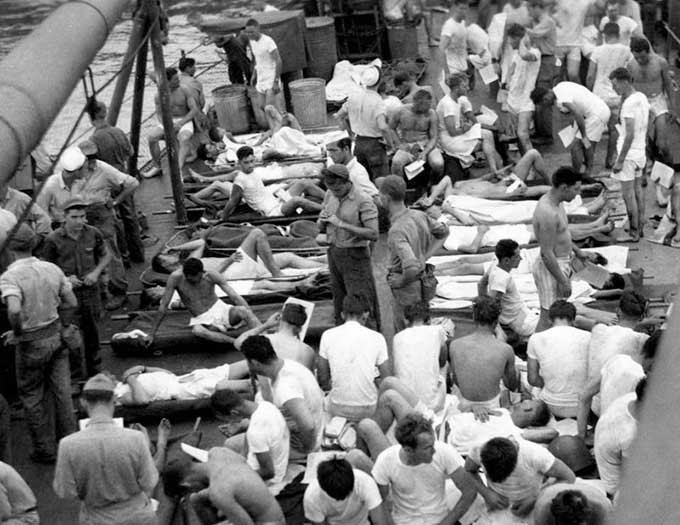Many crewmembers killed by sharks while waiting to be rescued

The delayed recovery of surviving crewmembers from the torpedoed USS Indianapolis in shark infested waters near the end of World War II was one of the worst tragedies in US Naval history. The Indianapolis was torpedoed by a Japanese submarine, just past midnight on July 30, 1945. It sank in 12 minutes. An estimated 300 of the 1,196 crewmembers went down with the ship. Only 321 were still alive when accidentally discovered four days later by a PV-1 Aircraft on routine patrol; 317 of those survived.
One survivor, Woody James, described his third day in the water: “The sun finally did rise and it got warmed up again. Some of the guys had been drinkin’ salt water by now, and they were goin’ bezerk. They’d tell you big stories about the Indianapolis is not sunk, its’ just right there under the surface. ‘I was just down there and had a drink of water out of the drinkin fountain and the Geedunk is still open.’ The geedunk being the commissary where you buy ice cream, cigarettes, candy, what have you, ‘it’s still open they’d tell ya. Come on we’ll go get a drink of water’, and then 3 or 4 guys would believe this story and go with them. The day wore on and the sharks were around, hundreds of them. You’d hear guys scream, especially late in the afternoon…Then they fed at night too. Everything would be quiet and then you’d hear somebody scream and you knew a shark had got him.” Shark Week episodes on the Discovery channel’s “Ocean of Fear” said this event had the most shark attacks on humans in recorded history. This show said most of the deaths were caused by exposure, thirst and salt poisoning with bodies dragged off by sharks.
Indy crewmembers watched planes pass every day. Some tried flashing with mirrors on their life vests but with no success. On the fourth day, the PV-1 Ventura pilot saw them. He dropped a life raft and reported his position. A PBY Catalina seaplane was sent out to verify. On the way, it overflew the Destroyer Escort. When alerted of the situation, the skipper changed course to help. Seeing men attacked by sharks, the pilot landed on the open sea and taxied to pick up the men at greatest risk. When his plane cabin was full, swimmers were tied to the top of the wings with parachute cord. The plane rescued 56 men. Arriving that night, the destroyer escort put searchlights on the water to locate survivors and ran a beam into the clouds to assist other rescuers to find the location. That exposed his ship to Japanese subs. They rescued 93 survivors and gave final rites to 21 found dead. Seven ships searched for survivors until August 8.
Indianapolis’s Commanding Officer was court martialed after the war. The main issue was that the cruiser was not following standard procedure to zigzag. The general consensus was that he was a “fall guy”. According to historians, he was the only Captain ever court martialed because his ship was sunk by an act of war. The conviction ended his career. He committed suicide in 1968.
The Indy was headed to the Philippines when the torpedo’s struck. An officer in Guam in charge of tracking ships knew it did not arrive timely but did not tell anyone. Meanwhile hundreds of sailors were dying daily. The ship sent out a distress signal that reached three communications centers. At one, the Commanding Officer was drunk. At a second, the CO had given orders to not be disturbed. And the third thought it was an enemy trap. This information was classified and not released until many years later, after the court martial.
Indianapolis survivors organized and worked hard to clear his name. The organization’s president wrote Congress saying “Capt. McVay’s court-martial was simply to divert attention from the terrible loss of life caused by procedural mistakes which never alerted anyone that we were missing.” Survivor Woody James added “…my firm belief, shared by all of us who survived, is that he was wrongly court-martialed. We believe there were many mistakes which contributed to the sinking, but they were not made by Captain McVay.” In October, 2000 Congress passed a resolution that Captain McVay’s record should reflect that “he is exonerated for the loss of the USS Indianapolis.” The resolution was signed by President Clinton.
Interestingly, the sinking of the Indianapolis was the last successful Japanese Naval action in World War II. Japan formally surrendered 15 days later. The submarine Commander, Mochitsura Hashimoto, later learned that relatives were killed at the atomic bombing at Hiroshima. His actions as a Naval Officer had been professional but the Hiroshima incident turned him bitter. He gradually forgave the US for the loss of his relatives and later became a Shinto Priest. He wrote to the Senate Armed Forces Committee “I would have been able to launch a successful torpedo attack against his ship whether it had been zigzagging or not.” He also wrote: “Our peoples have forgiven each other for that terrible war and its consequences. Perhaps it is time your peoples forgave Captain McVay for the humiliation of his unjust conviction.” Hashimoto attended the 48th Commemoration of the Bombing of Pearl Harbor in 1999. He met with the Indianapolis survivor group and told them he was there to pray for their crewmembers whose death he caused. They told him that they forgave him. He died at age 91 on October 25, 2000.




McVay talks to War Correspondents. 
Survivors covered with oil, served as sun screen. 
Indianapolis Commanding Officer, Captain McVay. 
Survivor Woody James in uniform in 1945. 
Commander Mochitsura Hashimoto.




















